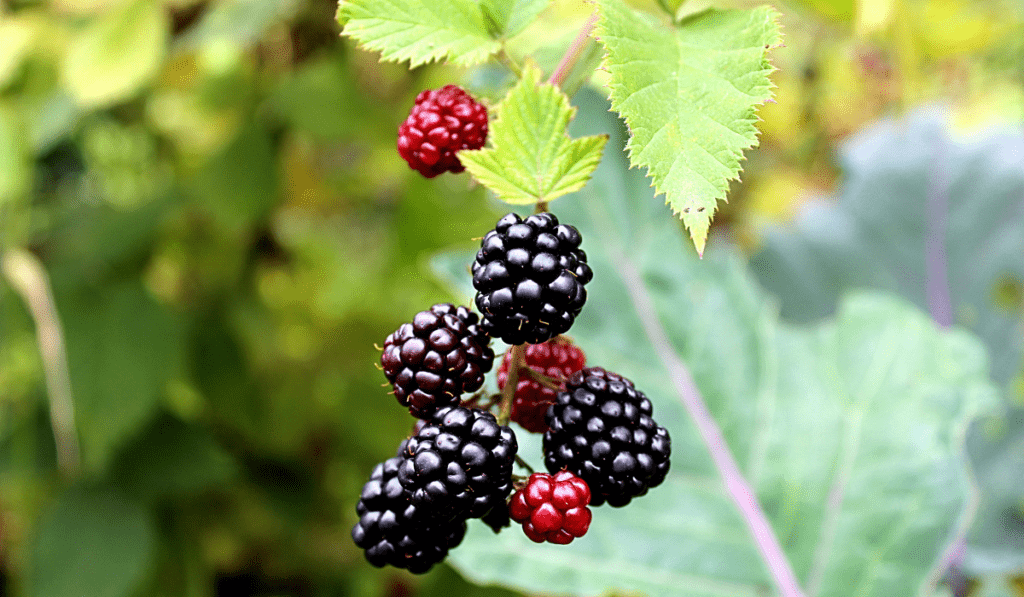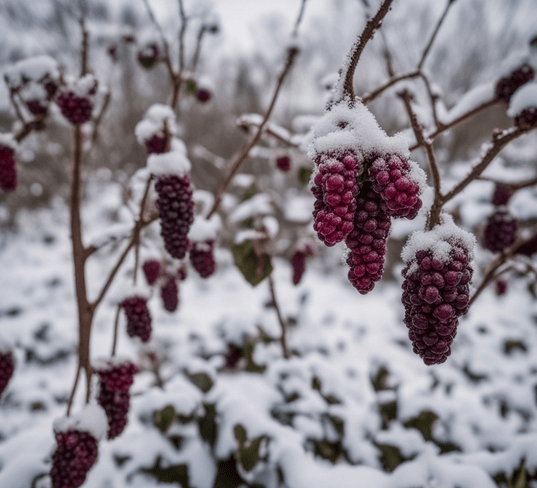Boysenberries are relatively easy to grow, making them a popular choice for home gardeners. They thrive in well-drained soil and require full sunlight. These resilient berries are resistant to many pests and diseases, simplifying the cultivation process. With proper care, including regular pruning and sufficient water, gardeners can enjoy a bountiful harvest of delicious boysenberries, making them an accessible and rewarding addition to home gardens.
Before we dive into the details, let’s take a moment to introduce boysenberries. Boysenberries are a unique hybrid fruit that originated in the United States in the 1920s. They were created by Rudolph Boysen, a horticulturist, by crossing raspberries, blackberries, and loganberries. The result is a berry that showcases the best characteristics of each parent fruit.
Boysenberries are known for their large size, deep maroon color, and exquisite flavor. They have a sweet-tart taste that is both refreshing and satisfying. These berries can be enjoyed fresh, used in jams, jellies, pies, and even made into delicious desserts. With their versatility and delectable taste, boysenberries have gained popularity among gardeners and culinary enthusiasts alike.
Understanding the Growing Conditions for Boysenberries
To successfully grow boysenberries, it is crucial to understand their preferred growing conditions. Boysenberries thrive in regions with mild climates, as they require a chilling period during winter to encourage fruit production. They prefer full sun exposure for at least six hours a day, but they can tolerate partial shade as well.
In terms of soil, boysenberries prefer well-draining soil with a pH level between 5.5 and 7.0. They dislike waterlogged soil, so it’s essential to ensure proper drainage. Amending the soil with organic matter, such as compost or aged manure, can improve its fertility and drainage capabilities.
Factors that Make Boysenberries Challenging to Grow
While boysenberries can be a delightful addition to your garden, they do come with a set of challenges. One factor that makes boysenberries challenging to grow is their susceptibility to certain diseases, such as powdery mildew and cane blight. These diseases can affect the health and productivity of the plants if not properly managed.
Another factor to consider is their vigorous growth habit. Boysenberries have trailing canes that can grow up to 15 feet long. Without proper support and pruning, they can become unruly and difficult to manage. Regular pruning is necessary to keep the plants in check and ensure optimal fruit production.
Furthermore, boysenberry plants require a trellis or support system to keep the canes off the ground. This helps prevent diseases and makes harvesting easier. Setting up a trellis system can be time-consuming and require some initial investment in materials.
Tips for Successful Boysenberry Cultivation
While boysenberries may present some challenges, with the right techniques and care, you can enjoy a bountiful harvest. Here are some tips for successful boysenberry cultivation:
- Choose the right variety: Select a boysenberry variety that is suitable for your climate and growing conditions. Some varieties are more resistant to diseases and better adapted to certain regions.
- Provide adequate support: Install a trellis or support system early on to train the canes and keep them off the ground. This will help prevent diseases and make harvesting easier.
- Prune regularly: Pruning is essential to control the growth of boysenberry canes and promote fruit production. Remove any dead or diseased canes, as well as any weak or overcrowded growth.
- Mulch and weed control: Apply a layer of organic mulch around the base of the plants to conserve moisture, suppress weeds, and regulate soil temperature. Regularly remove weeds to prevent competition for nutrients and water.
- Watering and fertilizing: Boysenberries require consistent moisture, especially during fruit development. Water deeply and regularly, providing about 1-2 inches of water per week. Fertilize with a balanced fertilizer in early spring and again after harvest.
By following these tips and providing the necessary care, you can ensure a successful boysenberry cultivation experience.
Common Problems and Solutions in Boysenberry Cultivation
Despite your best efforts, you may encounter some common problems while growing boysenberries. Here are a few issues you might face and their possible solutions:
- Disease and pest infestations: Boysenberries are susceptible to diseases such as powdery mildew and pests like aphids and spider mites. Regularly inspect your plants and treat any signs of disease or infestation promptly. Organic or chemical sprays may be used depending on your preference and the severity of the problem.
- Fruit rot: Boysenberries can develop fruit rot if they come into contact with damp soil or are not properly harvested. To prevent fruit rot, mulch around the plants to keep the fruit off the ground and ensure timely harvest when the berries are ripe.
- Lack of fruit production: If your boysenberry plants are not producing fruit, it could be due to inadequate pollination, improper pruning, or nutrient deficiencies. Ensure proper pollination by attracting bees and other pollinators to your garden. Prune the plants to remove old canes and promote new growth. Conduct a soil test to check for nutrient deficiencies and amend the soil accordingly.
By addressing these common problems promptly and implementing the appropriate solutions, you can overcome challenges and enjoy a successful boysenberry harvest.
How to Maintain and Care for Boysenberry Plants
Once your boysenberry plants are established, it is important to provide ongoing care and maintenance to ensure their health and productivity. Here are some essential maintenance tasks:
- Watering: Boysenberries require regular watering, especially during dry spells or hot weather. Water deeply and provide enough moisture to keep the soil consistently moist but not waterlogged.
- Fertilizing: Fertilize boysenberry plants twice a year, in early spring and after harvest, with a balanced fertilizer. Follow the manufacturer’s instructions for application rates and timing.
- Weed control: Regularly remove weeds from around the base of the plants to prevent competition for nutrients and water. Mulching can help suppress weed growth and conserve moisture.
- Support and pruning: Maintain the trellis or support system throughout the growing season. Regularly prune boysenberry canes to remove old or diseased growth and promote new, productive canes.
- Disease and pest management: Monitor your boysenberry plants for signs of diseases or pest infestations. Take proactive measures to prevent and treat any issues that arise, such as applying organic or chemical sprays as necessary.
By providing consistent care and maintenance, you can ensure the longevity and productivity of your boysenberry plants.
Delicious Recipes and Uses for Boysenberries
Boysenberries are incredibly versatile and can be used in a variety of delicious recipes. Here are a few ideas to make the most of your boysenberry harvest:
- Boysenberry pie: A classic and indulgent treat, boysenberry pie showcases the natural sweetness and vibrant color of the berries. Serve it warm with a scoop of vanilla ice cream for a truly delightful dessert.
- Boysenberry jam: Preserve the essence of boysenberries by making homemade boysenberry jam. Spread it on toast, swirl it into yogurt, or use it as a filling for pastries and cakes.
- Boysenberry smoothie: Cool down on a hot summer day with a refreshing boysenberry smoothie. Blend together boysenberries, yogurt, and a splash of orange juice for a nutritious and delicious beverage.
- Boysenberry sauce: Drizzle boysenberry sauce over pancakes, waffles, or ice cream for a burst of fruity flavor. You can also use it as a glaze for grilled meats or as a topping for cheesecakes and desserts.
These are just a few examples of the many ways you can enjoy boysenberries. Let your culinary creativity shine and explore new recipes to savor the unique taste of boysenberries.
Frequently Asked Questions about Growing Boysenberries
Can boysenberries be grown in containers?
Yes, boysenberries can be grown in containers as long as the container is large enough to accommodate the plant’s sprawling growth habit. Ensure proper drainage and provide a trellis or support system for the canes.
How long does it take for boysenberries to bear fruit?
Boysenberries typically start bearing fruit in their second year of growth. However, the exact timing can vary depending on the growing conditions and the specific variety.
Do boysenberries require a lot of maintenance?
Boysenberries require regular maintenance, including watering, pruning, and pest control. However, with proper care and attention, the maintenance tasks can be easily managed.
Can boysenberries be grown in all climates?
Boysenberries prefer mild climates with a chilling period during winter. They may not thrive in extremely hot or cold climates, so it’s important to choose varieties that are suitable for your specific climate.



